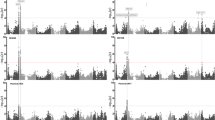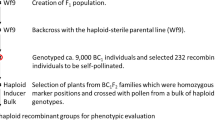Abstract
Effective tiller number is one of the most important traits for wheat (Triticum aestivum L.) yield, but the inheritance of tillering is poorly understood. A set of 168 doubled haploid (DH) lines derivatives of a cross between two winter wheat cultivars (Huapei 3 and Yumai 57), and an immortalized F2 (IF2) population generated by randomly permutated intermating of these DHs were investigated, and QTLs of tillering related to the maximum tillering of pre-winter (MTW), maximum tillering in spring (MTS), and effective tillering in harvest (ETH) were mapped. Phenotypic data were collected for the two populations from two different environments. Using inclusive composite interval mapping (ICIM), a total of 9 and 18 significant QTL were detected across environments for tillering in the DH and IF2 populations, respectively. Four QTLs were common between two populations. A major QTL located on the 5D chromosome with the allele originating from Yumai 57 was detected and increased 1.92 and 3.55 tillers in MTW and MTS, respectively. QTLs (QMts6D, QEth6D) having a neighbouring marker interval at Xswes679.1 and Xcfa2129 on chromosome 6D was detected in MTS and ETH. These results provide a better understanding of the genetic factors for selectively expressing the control of tiller number in different growth stages and facilitate marker-assisted selection strategy in breeding.
Similar content being viewed by others
References
Babb S. and Muehlbauer G. J. 2003 Genetic and morphological characterization of the barley uniculm2 (cul2) mutant. Theor. Appl. Genet. 106, 846–857.
Brondani C., Rangel P., Brondani R. and Ferreira M. 2002 QTL mapping and introgression of yield related traits from Oryza glumaepatula to cultivated rice (Oryza sativa) using microsatellite markers. Theor. Appl. Genet. 104, 1192–1203.
Buck-Sorlin G. H. 2002 The search for QTL in barley (Hordeum vulgare L.) using a new mapping population. Cell Mol. Biol. Lett. 7, 523–535.
Evers J. B., Vos J., Andrieu B. and Struik P. C. 2006 Cessation of tillering in spring wheat in relation to light interception and red: far-red ratio. Ann. Bot. 97, 649–658.
Franckowiak J. D., Kleinhofs A. and Lundqvist U. 2005 Descriptions of barley genetic stocks for 2005. Barley Genet. Newslett. 35, 155–210 (in Chinese).
Guo C. Q., Bai Z. A., Liao P. A. and Jin W. K. 2004 New high quality and yield wheat variety Yumai 57. China Seed 4, 54 (in Chinese).
Hai Y. and Kang M.-H. 2007 Breeding of a new wheat variety Huapei 3 with high yield and early maturing. Henan Agric. Sci. 5, 36–37 (in Chinese).
Hodges T. 1991 Predicting crop phenology. CRC Press, Boca Raton, USA.
Hua J. P. 2001 Genetic disseetion on the basis of heterosis using an ‘Immortalized F 2’ population. Ph. D. thesis, Huazhong Agricultural University, Wuhan, P R China.
Hua J. P., Xing Y. Z., Wu W. R., Xu C. G., Sun X. L., Yu S. B. and Zhang Q. F. 2003 Single-locus heterotic effects and dominance by dominance interaction can adequately explain the genetic basis of heterosis in an elite hybrid. Proc. Natl. Acad. Sci. USA 100, 2574–2579.
Huang X. Q., Coster H., Ganal M. W. and Röder M. S. 2003 Advanced backcross QTL analysis for the identification of quantitative trait loci alleles from wild relatives of wheat (Triticum aestivum L.). Theor. Appl. Genet. 106, 1379–1389.
Kato K., Miura H. and Sawada S. 2000 Mapping QTLs controlling grain yield and its components on chromosome 5A of wheat. Theor. Appl. Genet. 101, 1114–1121.
Kirby E. J. M. and Appleyard M. 1981 Cereal development guide. Cereal Unit, National Agricultural Centre, Stoneleigh, UK.
Kuraparthy V., Sood S., Dhaliwal H. S., Chhuneja P. and Gill B. S. 2007 Identification and mapping of a tiller inhibition gene (tin3) in wheat. Theor. Appl. Genet. 114, 285–294.
Law C. N. 1967 The location of genetic factors controlling a number of quantitative characters in wheat. Genetics 56, 445–461.
Li H., Ye G. and Wang J. 2007 A modified algorithm for the improvement of composite interval mapping. Genetics 175, 361–374.
Li H., Ribaut J. M., Li Z. and Wang J. 2008 Inclusive composite interval mapping (ICIM) for digenic epistasis of quantitative traits in biparental populations. Theor. Appl. Genet. 116, 243–260.
Li W. L., Nelson J. C., Chu C. Y., Shi L. H., Huang S. H. and Liu D. J. 2002 Chromosomal locations and genetic relationships of tiller and spike characters in wheat. Euphytica 125, 357–366.
Li X. Y., Qian Q., Fu Z. M., Wang Y. H., Xiong G. S., Zeng D. L. et al. 2003 Control of tillering in rice. Nature 422, 618–621.
Liu G. F., Xu H. M., Yang J. and Zhu J. 2006 Genetic analysis on tiller number and plant height per plant in rice (Oryza sativa L.). J. Zhejiang University 32, 527–534 (in Chinese).
Liu G. F., Zeng R. Z., Zhu H. T., Zhang Z. M., Ding X. H., Zhao F. M. et al. 2009 Dynamic expression of nine QTLs for tiller number detected with single segment substitution lines in rice. Theor. Appl. Genet. 118, 443–453.
Lukaszewski A. J., Rybka K., Korzun V., Malyshev S. V., Lapinski B. and Whitkus R. 2004 Genetic and physical mapping of homoeologous recombination points involving wheat chromosome 2B and rye chromosome 2R. Genome 47, 36–45.
Malyshev S., Korzun V., Voylokov A., Smirnov V. and Börner A. 2001 Linkage mapping of mutant loci in rye (Secale cereale L.). Theor. Appl. Genet. 103, 70–74.
Miralles D. J. and Richards R. A. 2000 Responses of leaf and tiller emergence and primordium initiation in wheat and barley to interchanged photoperiod. Ann. Bot. 85, 655–663.
Narasimhamoorthy B., Gill B. S., Fritz A. K., Nelson J. C. and Brown-Guedira G. L. 2006 Advanced backcross QTL analysis of a hard winter wheat × synthetic wheat population. Theor. Appl. Genet. 112, 787–796.
Satorre E. H. and Slafer G. A. 1999 Wheat: ecology and physiology of yield determination. Haworth Press, Binghamton, USA.
Shah M. M., Gill K. S., Baenziger P. S., Yen Y., Kaeppler S. M. and Ariyarathne H. M. 1999 Molecular mapping of loci for agronomic traits on chromosome 3A of bread wheat. Crop Sci. 39, 1728–1732.
Tian D. G., Lin F., Zhang C. Q., Zhang Z. Z., Xue S. L., Cao Y. et al. 2008 Mapping QTLs associated with resistance to Fusarium head blight using an “Immortalized F2” population. Acta Agron. Sin. 34, 539–544.
Wang J. K. 2009 Inclusive composite interval mapping of quantitative trait genes. Acta Agron. Sin. 35, 1–7.
Yamada T., Jones E. S., Cogan N. O. I., Vecchies A. C., Nomura T., Hisano H. et al. 2004 QTL analysis of morphological, developmental, and winter hardiness-associated traits in perennial rye grass. Crop Sci. 44, 925–935.
Yan J. Q., Zhu J., He C. X., Benmoussa M. and Wu P. 1998 Quantitative trait loci analysis for the developmental behavior of tiller number in rice (Oryza sativa L.). Theor. Appl. Genet. 97, 267–274.
Yang G. H., Xing Y. Z., Li S., Ding J. Z., Yue B., Deng K. et al. 2006 Molecular dissection of developmental behavior of tiller number and plant height and their relationship in rice (Oryza sativa L.). Hereditas 143, 236–245.
Zhang L., Li H., Li Z. and Wang J. 2008 Interactions between markers can be caused by the dominance effect of QTL. Genetics 180, 1177–1190.
Zhang K. P., Tian J. C., Zhao L., Liu B. and Chen G. F. 2009 Detection of quantitative trait loci for heading date based on the doubled haploid progeny of two elite Chinese wheat cultivars. Genetica 135, 257–265.
Zhao F. M., Liu G. F., Zhu H. T., Ding X. H., Zeng R. H., Zhang Z. M. et al. 2008 Unconditional and conditional QTL mapping for tiller numbers at various stages with single segment substitution lines in rice (Oryza sativa L.). Agric. Sci. Chin. 713, 257–265 (in Chinese).
Zhu J. 1995 Analysis of conditional genetic effects and variance components in developmental genetics. Genetics 141, 1633–1639.
Author information
Authors and Affiliations
Corresponding author
Rights and permissions
About this article
Cite this article
Li, Z., Peng, T., Xie, Q. et al. Mapping of QTL for tiller number at different stages of growth in wheat using double haploid and immortalized F2 populations. J Genet 89, 409 (2010). https://doi.org/10.1007/s12041-010-0059-1
Received:
Revised:
Accepted:
Published:
DOI: https://doi.org/10.1007/s12041-010-0059-1




